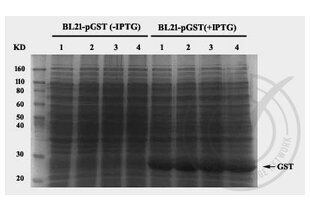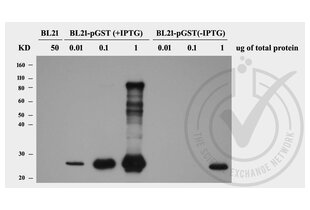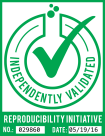GST-Tag 抗体
-
- 抗原 See all GST-Tag products
- GST-Tag
-
适用
- Schistosoma japonicum
-
宿主
- 小鼠
-
克隆类型
- 单克隆
-
标记
- This GST-Tag antibody is un-conjugated
-
应用范围
- Western Blotting (WB), Immunoprecipitation (IP), Immunohistochemistry (IHC), Chromatin Immunoprecipitation (ChIP)
- 产品特性
- The GST tag issued in many protocols
- 纯化方法
- purified form hybridoma supernatant
- 免疫原
- GST
- 克隆位点
- 5C12
- 亚型
- IgG1
-
-
- 应用备注
- WB 0.1-1.0ug/ml
- 限制
- 仅限研究用
-
- by
- Celplor LLC
- No.
- #029860
- 日期
- 2016.05.19
- 抗原
- Mouse anti-GST monoclonal antibody
- Lot Number
- 1214
- Method validated
- Western Blotting
- Positive Control
- BL21 bacteria cells were transformed with an in-house GST expression vector pGST
- Negative Control
- Empty vector cell lysate
- Notes
- Based on the 12% GST content in total cell lysate of BL21-pGST (+IPTG), there is an estimated 1 ng of GST protein in 0.01 ug of total protein with IPTG induction. Therefore, the detection limit of mouse anti-GST monoclonal antibody is lower than 1 ng of GST protein.
- Primary Antibody
- Antibody: Mouse anti-GST monoclonal antibody
- Lot number: 1214
- Dilution: 1:1000
- Secondary Antibody
- Antibody: HRP labeled secondary anti-mouse antibody
- Lot number: 390630
- Dilution: 1:2000
- Full Protocol
- **I. Reagent preparation**
- 1. BL21 bacteria cells were transformed with an in-house GST expression vector pGST.
- 2. Individual colony was inoculated in 2xYT medium and cultured at 37°C with shaking for 5 hrs followed by IPTG (1mM) induction for 2 hrs. Bacteria was grown to OD600=0.6-0.8 (5 hr) when IPTG was added.
- 3. Cells were centrifuged at top speed and pellets were collected.
- 4. Cell pellets were lysed in SDS-PAGE sample buffer.
- 5. Protein concentration was assayed using DC protein assay kit (Bio-Rad).
- 6. 50 ug of cell lysate was loaded and protein was separated by SDS-PAGE.
- 7. Gel was stained with SimplyBlue Safe Stain (Invitrogen) at room temperature.
- 8. GST content in IPTG induced samples was analyzed by Quantity One software (Bio-Rad).
- **II. Western blot validation**
- 1. Cell lysates from BL21 host cells, BL21-pGST transformed cells with or without IPTG induction were loaded and proteins were separated by SDS-PAGE followed by Western transfer to a nitrocellulose membrane.
- 2. Membrane was blocked with 2% powder milk (Bio-Rad) for 1 hr at room temperature.
- 3. Membrane was incubated with mouse anti-GST monoclonal antibody (1:1000 dilution) at 4°C overnight with shaking.
- 4. Membrane was washed with TBST three times for 10 min.
- 5. After washing, membrane was incubated with HRP labeled secondary anti-mouse antibody (1:2000 dilution, GE Healthcare) with shaking at room temperature for 1 hr.
- 6. Membrane was washed with TBST three times for 10 min.
- 7. After washing, membrane was incubated with SuperSignal West Pico substrate (Thermo Scientific) for 5 min at room temperature.
- 8. Membrane was analyzed by ChemiDoc XRS gel documentation system (Bio-Rad).
- Experimental Notes
生效 #029860 (Western Blotting)![成功验证 '独立验证'标志]()
![成功验证 '独立验证'标志]() Validation Images
Validation Images![Figure 2: Western blot for mouse anti-GST monoclonal antibody. The first lane shows the empty vector cell lysate (negative control). This is followed by a 0.01, 0.1, and 1 ug of total protein from BL21-pGST, with (Lanes 2, 3, and 4) or without (Lanes 5, 6, and 7) IPTG induction, respectively.
Based on the 12% GST content in total cell lysate of BL21-pGST (+IPTG), there is an
estimated 1 ng of GST protein in 0.01 ug of total protein with IPTG induction. Therefore,
the detection limit of mouse anti-GST monoclonal antibody is lower than 1 ng of GST
protein. The higher than expected molecular weight may be the result GST dimers or aggregates (Riley et al. Protein Engineering vol.9 no.2 pp.223-23O, 1996).]() Figure 2: Western blot for mouse anti-GST monoclonal antibody. The first lane shows the empty vector cell lysate (negative control). This is followed by a 0.01, 0.1, and 1 ug of total protein from BL21-pGST, with (Lanes 2, 3, and 4) or without (Lanes 5, 6, and 7) IPTG induction, respectively.
Based on the 12% GST content in total cell lysate of BL21-pGST (+IPTG), there is an
estimated 1 ng of GST protein in 0.01 ug of total protein with IPTG induction. Therefore,
the detection limit of mouse anti-GST monoclonal antibody is lower than 1 ng of GST
protein. The higher than expected molecular weight may be the result GST dimers or aggregates (Riley et al. Protein Engineering vol.9 no.2 pp.223-23O, 1996).
Full Methods
Figure 2: Western blot for mouse anti-GST monoclonal antibody. The first lane shows the empty vector cell lysate (negative control). This is followed by a 0.01, 0.1, and 1 ug of total protein from BL21-pGST, with (Lanes 2, 3, and 4) or without (Lanes 5, 6, and 7) IPTG induction, respectively.
Based on the 12% GST content in total cell lysate of BL21-pGST (+IPTG), there is an
estimated 1 ng of GST protein in 0.01 ug of total protein with IPTG induction. Therefore,
the detection limit of mouse anti-GST monoclonal antibody is lower than 1 ng of GST
protein. The higher than expected molecular weight may be the result GST dimers or aggregates (Riley et al. Protein Engineering vol.9 no.2 pp.223-23O, 1996).
Full Methods -
- 状态
- Liquid
- 浓度
- 1 mg/mL
- 缓冲液
- PBS pH7.2
- 储存条件
- -20 °C
-
- 抗原
- GST-Tag
- 别名
- GST Tag (GST-Tag 产品)
- 物质类
- Tag
- 分子量
- 26 kDa
- UniProt
- P08515
-



 (1 validation)
(1 validation)



